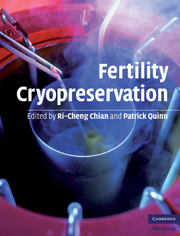Book contents
- Fertility Cryopreservation
- Fertility Cryopreservation
- Copyright page
- Contents
- Contributors
- Preface
- Acknowledgements
- Cryobiology
- Cryopreservation of sperm and testicular tissue
- Cryopreservation of embryos
- Section 4 Cryopreservation of oocytes
- Section 5 Cryopreservation of ovarian tissue
- Ethical considerations
- Appendix 1 Autotransplantation of cryopreserved thawed human ovarian tissue
- Index
Section 4 - Cryopreservation of oocytes
Published online by Cambridge University Press: 06 July 2010
- Fertility Cryopreservation
- Fertility Cryopreservation
- Copyright page
- Contents
- Contributors
- Preface
- Acknowledgements
- Cryobiology
- Cryopreservation of sperm and testicular tissue
- Cryopreservation of embryos
- Section 4 Cryopreservation of oocytes
- Section 5 Cryopreservation of ovarian tissue
- Ethical considerations
- Appendix 1 Autotransplantation of cryopreserved thawed human ovarian tissue
- Index
Summary
- Type
- Chapter
- Information
- Fertility Cryopreservation , pp. 114 - 188Publisher: Cambridge University PressPrint publication year: 2010
- 1
- Cited by

